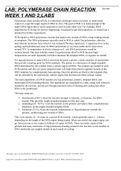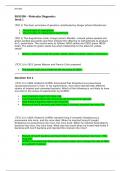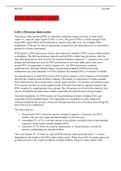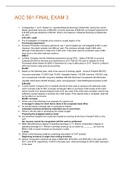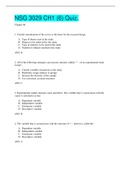Bios 390 week 1 lab 1 - Study guides, Class notes & Summaries
Looking for the best study guides, study notes and summaries about Bios 390 week 1 lab 1? On this page you'll find 35 study documents about Bios 390 week 1 lab 1.
Page 2 out of 35 results
Sort by
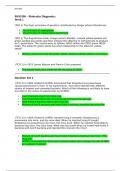
-
BIOS 390 Molecular Biology Week 1-7 Exam Study Guide with Lab Reports- Complete Guide (Download to score an A) 2021.pdf
- Exam (elaborations) • 47 pages • 2023
-
- $12.49
- + learn more
BIOS 390 Molecular Biology Week 1-7 Exam Study Guide with Lab Reports- Complete Guide (Download to score an A) BIOS 390 Molecular Biology Week 1-7 Exam Study Guide with Lab Reports- Complete Guide (Download to score an A) BIOS 390 Molecular Biology Week 1-7 Exam Study Guide with Lab Reports- Complete Guide (Download to score an A) BIOS 390 Molecular Biology Week 1-7 Exam Study Guide with Lab Reports- Complete Guide (Download to score an A) BIOS 390 Molecular Biology Week 1-7 Exam Study Guide wit...
BIOS 390 Week 1 LAB 1 LAB 1: Polymerase chain reaction
BIOS 390 Week 1, 2 LAB 1
BIOS 390 Molecular Biology Week 1-7 Exam Study Guide with Lab Reports- Complete Guide (Download to

-
BIOS 390 Week 1 LAB 1
- Case • 4 pages • 2021
-
- $10.00
- + learn more
BIOS 390 Week 1 LAB 1 LAB 1: Polymerase chain reaction Polymerase chain reaction (PCR) is a laboratory technique used to increase, or make many copies of, a specific target region of DNA in vitro. The goal of PCR is to make enough of the target DNA region that it can be analyzed or used in some other way. For example, DNA amplified by PCR may be sent for sequencing, visualized by gel electrophoresis, or cloned into a plasmid for further experiments. PCR requires a DNA polymerase enzyme tha...
BIOS 390 Week 1 LAB 1
BIOS 390 Week 1 LAB 1
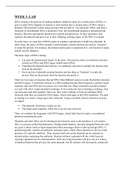
-
BIOS 390 ERIC KYLE WEEK 3 & 4 : LAB
- Exam (elaborations) • 4 pages • 2021
-
- $10.49
- + learn more
BIOS 390 ERIC KYLE WEEK 3 & 4 : LAB DNA cloning is the process of making multiple, identical copies of a certain piece of DNA. A gene or other DNA fragment of interest is first inserted into a circular piece of DNA called a plasmid. The insertion is done using enzymes that are able to “cut and paste” DNA, and then a molecule of recombinant DNA is produced. Next, the recombinant plasmid is introduced into bacteria. Bacteria carrying the plasmid are selected and grown up. As they reproduce, ...
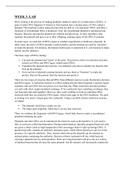
-
BIOS 390 ERIC KYLE WEEK 3 & 4 : LAB
- Exam (elaborations) • 4 pages • 2021
-
- $10.49
- + learn more
BIOS 390 ERIC KYLE WEEK 3 & 4 : LAB DNA cloning is the process of making multiple, identical copies of a certain piece of DNA. A gene or other DNA fragment of interest is first inserted into a circular piece of DNA called a plasmid. The insertion is done using enzymes that are able to “cut and paste” DNA, and then a molecule of recombinant DNA is produced. Next, the recombinant plasmid is introduced into bacteria. Bacteria carrying the plasmid are selected and grown up. As they reproduce, ...

How did he do that? By selling his study resources on Stuvia. Try it yourself! Discover all about earning on Stuvia


